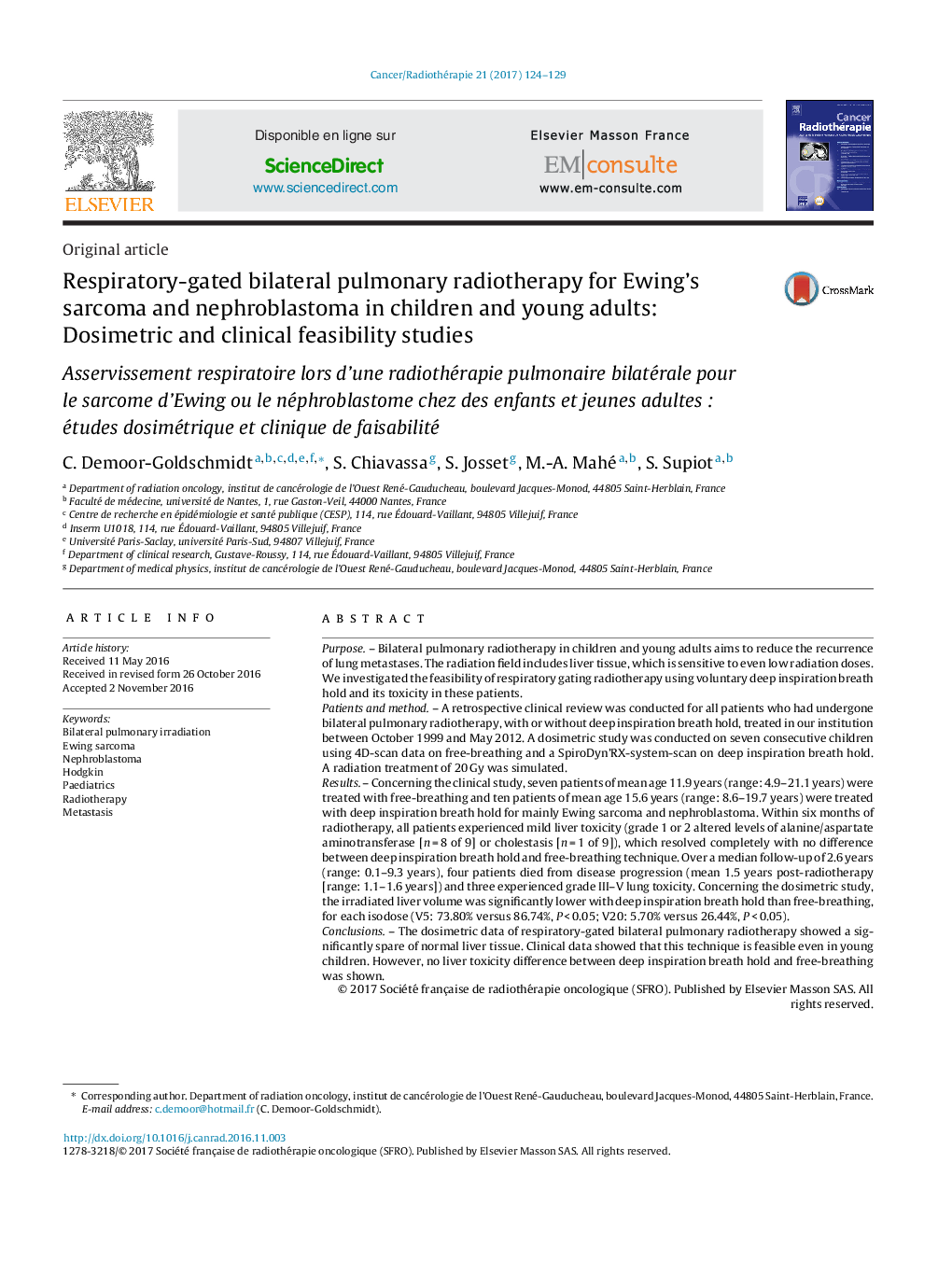| کد مقاله | کد نشریه | سال انتشار | مقاله انگلیسی | نسخه تمام متن |
|---|---|---|---|---|
| 5525922 | 1401506 | 2017 | 6 صفحه PDF | دانلود رایگان |

PurposeBilateral pulmonary radiotherapy in children and young adults aims to reduce the recurrence of lung metastases. The radiation field includes liver tissue, which is sensitive to even low radiation doses. We investigated the feasibility of respiratory gating radiotherapy using voluntary deep inspiration breath hold and its toxicity in these patients.Patients and methodA retrospective clinical review was conducted for all patients who had undergone bilateral pulmonary radiotherapy, with or without deep inspiration breath hold, treated in our institution between October 1999 and May 2012. A dosimetric study was conducted on seven consecutive children using 4D-scan data on free-breathing and a SpiroDyn'RX-system-scan on deep inspiration breath hold. A radiation treatment of 20 Gy was simulated.ResultsConcerning the clinical study, seven patients of mean age 11.9 years (range: 4.9-21.1 years) were treated with free-breathing and ten patients of mean age 15.6 years (range: 8.6-19.7 years) were treated with deep inspiration breath hold for mainly Ewing sarcoma and nephroblastoma. Within six months of radiotherapy, all patients experienced mild liver toxicity (grade 1 or 2 altered levels of alanine/aspartate aminotransferase [n = 8 of 9] or cholestasis [n = 1 of 9]), which resolved completely with no difference between deep inspiration breath hold and free-breathing technique. Over a median follow-up of 2.6 years (range: 0.1-9.3 years), four patients died from disease progression (mean 1.5 years post-radiotherapy [range: 1.1-1.6 years]) and three experienced grade III-V lung toxicity. Concerning the dosimetric study, the irradiated liver volume was significantly lower with deep inspiration breath hold than free-breathing, for each isodose (V5: 73.80% versus 86.74%, P < 0.05; V20: 5.70% versus 26.44%, P < 0.05).ConclusionsThe dosimetric data of respiratory-gated bilateral pulmonary radiotherapy showed a significantly spare of normal liver tissue. Clinical data showed that this technique is feasible even in young children. However, no liver toxicity difference between deep inspiration breath hold and free-breathing was shown.
RésuméObjectif de l'étudeLa radiothérapie pulmonaire bilatérale vise chez les enfants et les jeunes adultes à réduire la récidive des métastases pulmonaires. Une partie du tissu hépatique situé à proximité est incluse dans le volume irradié. Or ce tissu est sensible au rayonnement ionisant dès de faibles doses. Nous avons étudié la faisabilité d'un traitement par asservissement respiratoire selon la technique de blocage en inspiration profonde volontaire et sa toxicité chez ces patients.Patients et méthodeUne étude clinique rétrospective a été réalisée pour tous les patients qui avaient eu une radiothérapie pulmonaire bilatérale, avec ou sans blocage en inspiration profonde volontaire, dans notre institution entre octobre 1999 et mai 2012. Une étude dosimétrique, avec une dose de 20 Gy, a été menée sur sept enfants consécutifs à l'aide de données obtenues par scanographie quadridimensionnelle en respiration libre et par scanographie en inspiration profonde volontaire bloquée avec le système SpiroDyn'RX.RésultatsEn ce qui concerne l'étude clinique, sept patients d'âge moyen 11,9 ans (4,9-21,1 ans) ont été traités en respiration libre et dix patients de moyenne d'âge de 15,6 ans (8,6-19,7 ans) ont été traités en inspiration profonde volontaire bloquée, principalement pour des sarcomes d'Ewing et des néphroblastomes. Dans les six mois de la radiothérapie, tous les patients ont connu une légère toxicité hépatique (de grade 1 ou 2, avec des dosages perturbés de transaminases [ALAT/ASAT ; n = 8 sur 9] ou des cholestases [n = 1 sur 9]), avec une normalisation complète sans différence entre inspiration profonde volontaire bloquée et respiration libre. Au cours d'un suivi médian de 2,6 ans (0,1-9,3 ans), quatre patients sont décédés de progression de la maladie et trois ont souffert de toxicité pulmonaire de grade III-V (1,5 ans après la radiothérapie en moyenne [1,1-1,6 ans]). En ce qui concerne l'étude dosimétrique, le volume du foie irradié était significativement plus faible en inspiration profonde volontaire bloquée qu'en respiration libre, pour chacune des isodoses (volume recevant 5 Gy [V5] : 73,80 % contre 86,74 %, p < 0,05 ; volume recevant 20 Gy [V20] : 5,70 % contre 26,44 %, p < 0,05).ConclusionsL'analyse des données dosimétriques d'une radiothérapie pulmonaire bilatérale en inspiration profonde volontaire bloquée a significativement montré une meilleure protection du tissu hépatique. Celle des données cliniques a montré que cette technique est envisageable, même chez les jeunes enfants. Cependant, aucune différence de toxicité hépatique entre l'inspiration profonde volontaire bloquée et la respiration libre n'a été montrée.
Journal: Cancer/Radiothérapie - Volume 21, Issue 2, April 2017, Pages 124-129